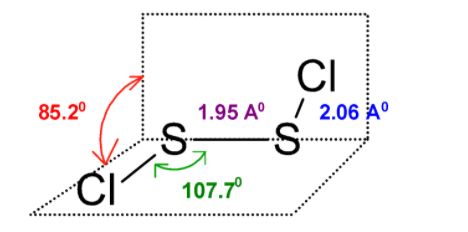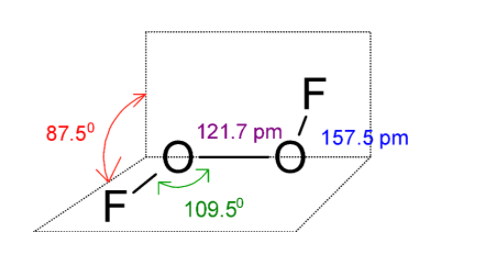
The shape of $\text{ }{{\text{H}}_{\text{2}}}{{\text{S}}_{\text{2 }}}$ is identical to that of:
(This question has multiple correct options)
A) ${{\text{S}}_{\text{2}}}\text{C}{{\text{l}}_{\text{2}}}\text{ }$
B) ${{\text{O}}_{\text{2}}}{{\text{F}}_{\text{2}}}$
C) ${{\text{C}}_{\text{2}}}{{\text{F}}_{\text{2}}}$
D) ${{\text{H}}_{\text{2}}}{{\text{O}}_{\text{2}}}\text{ }$
Answer
560.7k+ views
Hint: The bonding in the sulphur in sulphur hydrogen is different than the usual. This is particularly because of the very short distance between $\text{S}-\text{S }$ the bond and a long-distance along with the \[\text{S}-\text{H }\]bond. Thus the two \[\text{S}-\text{H }\] bonds are arranged in the two planes perpendicular to each other. Such that the $\text{ }{{\text{H}}_{\text{2}}}{{\text{S}}_{\text{2 }}}$ exhibits an open book structure.
Complete answer:
The $\text{ }{{\text{H}}_{\text{2}}}{{\text{S}}_{\text{2 }}}$ has a large dihedral angle that approaches $\text{90}\text{.}{{\text{6}}^{\text{0}}}\text{ }$ and has ${{\text{C}}_{\text{2}}}$ an axis of symmetry.
The VSEPR theory is used to decide the geometry of$\text{ }{{\text{H}}_{\text{2}}}{{\text{S}}_{\text{2 }}}$.
The two sulphur atoms are bonded by the disulphide linkage. Each sulphur atom is bonded to a hydrogen atom. The Lewis dot structure for the $\text{ }{{\text{H}}_{\text{2}}}{{\text{S}}_{\text{2 }}}$ is as follows:

This $\text{ }{{\text{H}}_{\text{2}}}{{\text{S}}_{\text{2 }}}$ is an open book type structure. Since the sulphur has the two-electron pair the structure cannot be linear but it is like the hydrogen atom is in a different plane. The structure is as follows:

Let's have a look at the option.
A)$\text{ }{{\text{S}}_{\text{2}}}\text{C}{{\text{l}}_{\text{2}}}\text{ }$ :
In $\text{ }{{\text{S}}_{\text{2}}}\text{C}{{\text{l}}_{\text{2}}}\text{ }$ , the two sulphur atoms are forming a covalent bond and each sulphur is bonded to the two chlorine atom. The structure of the $\text{ }{{\text{S}}_{\text{2}}}\text{C}{{\text{l}}_{\text{2}}}\text{ }$ is as shown below:

The two sulphur atoms share one bond and this is a disulphide linkage. The disulphur dichloride structure is nonlinear .Because the chlorine atom is big and reduces planarity. Thus $\text{ }{{\text{S}}_{\text{2}}}\text{C}{{\text{l}}_{\text{2}}}\text{ }$ is an open book structure.
B) ${{\text{O}}_{\text{2}}}{{\text{F}}_{\text{2}}}$:
In ${{\text{O}}_{\text{2}}}{{\text{F}}_{\text{2}}}$ , oxygen atoms are bonded through peroxide linkage. This ${{\text{O}}_{\text{2}}}{{\text{F}}_{\text{2}}}$ is an open book type structure. Since the oxygen has the two-electron pair the structure cannot be linear but it is like the fluorine atom is in a different plane. The structure is as follows:

C)${{\text{C}}_{\text{2}}}{{\text{F}}_{\text{2}}}$:
In ${{\text{C}}_{\text{2}}}{{\text{F}}_{\text{2}}}$ , the two carbon atoms are forming a covalent bond and each carbon is bonded to the two fluorine atom. The structure of the ${{\text{C}}_{\text{2}}}{{\text{F}}_{\text{2}}}$ is as shown below:

The two carbon atoms share the three bonds. Since the carbon is $\text{sp}$ hybridized. They ${{\text{C}}_{\text{2}}}{{\text{F}}_{\text{2}}}$ have a linear structure.
D) ${{\text{H}}_{\text{2}}}{{\text{O}}_{\text{2}}}\text{ }$:
Hydrogen peroxide ${{\text{H}}_{\text{2}}}{{\text{O}}_{\text{2}}}\text{ }$ is a nonplanar molecule. Two oxygen are bonded with each other forming a peroxide bond. Each oxygen atom is bonded to the hydrogen atom. Since each oxygen has two lone pairs of electrons on it. The structure is not planar. Instead of that, it is non-planar when two hydrogen atoms are in a different plane. It has an open book structure as shown below.

Thus the shape of $\text{ }{{\text{H}}_{\text{2}}}{{\text{S}}_{\text{2}}}\text{ }$ is identical to that of $\text{ }{{\text{S}}_{\text{2}}}\text{C}{{\text{l}}_{\text{2}}}\text{ }$, ${{\text{O}}_{\text{2}}}{{\text{F}}_{\text{2}}}$, ${{\text{H}}_{\text{2}}}{{\text{O}}_{\text{2}}}\text{ }$.
Hence, (A), (B), and (D) is the correct option.
Note: In general cases, the sulphur exhibits the $-2$ oxidation state. Sulphur in disulphide has an unusual oxidation state. In$\text{ }{{\text{H}}_{\text{2}}}{{\text{S}}_{\text{2}}}\text{ }$, sulphur shows $\text{ }-\text{1 }$ an oxidation state as H is less electronegative than a sulphur atom. However in $\text{ }{{\text{S}}_{\text{2}}}\text{C}{{\text{l}}_{\text{2}}}\text{ }$sulphur is less electronegative than the chlorine atom. Thus the oxidation state of sulphur is $\text{ +1 }$ and of chlorine is $\text{ }-\text{1 }$.
Complete answer:
The $\text{ }{{\text{H}}_{\text{2}}}{{\text{S}}_{\text{2 }}}$ has a large dihedral angle that approaches $\text{90}\text{.}{{\text{6}}^{\text{0}}}\text{ }$ and has ${{\text{C}}_{\text{2}}}$ an axis of symmetry.
The VSEPR theory is used to decide the geometry of$\text{ }{{\text{H}}_{\text{2}}}{{\text{S}}_{\text{2 }}}$.
The two sulphur atoms are bonded by the disulphide linkage. Each sulphur atom is bonded to a hydrogen atom. The Lewis dot structure for the $\text{ }{{\text{H}}_{\text{2}}}{{\text{S}}_{\text{2 }}}$ is as follows:

This $\text{ }{{\text{H}}_{\text{2}}}{{\text{S}}_{\text{2 }}}$ is an open book type structure. Since the sulphur has the two-electron pair the structure cannot be linear but it is like the hydrogen atom is in a different plane. The structure is as follows:

Let's have a look at the option.
A)$\text{ }{{\text{S}}_{\text{2}}}\text{C}{{\text{l}}_{\text{2}}}\text{ }$ :
In $\text{ }{{\text{S}}_{\text{2}}}\text{C}{{\text{l}}_{\text{2}}}\text{ }$ , the two sulphur atoms are forming a covalent bond and each sulphur is bonded to the two chlorine atom. The structure of the $\text{ }{{\text{S}}_{\text{2}}}\text{C}{{\text{l}}_{\text{2}}}\text{ }$ is as shown below:

The two sulphur atoms share one bond and this is a disulphide linkage. The disulphur dichloride structure is nonlinear .Because the chlorine atom is big and reduces planarity. Thus $\text{ }{{\text{S}}_{\text{2}}}\text{C}{{\text{l}}_{\text{2}}}\text{ }$ is an open book structure.
B) ${{\text{O}}_{\text{2}}}{{\text{F}}_{\text{2}}}$:
In ${{\text{O}}_{\text{2}}}{{\text{F}}_{\text{2}}}$ , oxygen atoms are bonded through peroxide linkage. This ${{\text{O}}_{\text{2}}}{{\text{F}}_{\text{2}}}$ is an open book type structure. Since the oxygen has the two-electron pair the structure cannot be linear but it is like the fluorine atom is in a different plane. The structure is as follows:

C)${{\text{C}}_{\text{2}}}{{\text{F}}_{\text{2}}}$:
In ${{\text{C}}_{\text{2}}}{{\text{F}}_{\text{2}}}$ , the two carbon atoms are forming a covalent bond and each carbon is bonded to the two fluorine atom. The structure of the ${{\text{C}}_{\text{2}}}{{\text{F}}_{\text{2}}}$ is as shown below:

The two carbon atoms share the three bonds. Since the carbon is $\text{sp}$ hybridized. They ${{\text{C}}_{\text{2}}}{{\text{F}}_{\text{2}}}$ have a linear structure.
D) ${{\text{H}}_{\text{2}}}{{\text{O}}_{\text{2}}}\text{ }$:
Hydrogen peroxide ${{\text{H}}_{\text{2}}}{{\text{O}}_{\text{2}}}\text{ }$ is a nonplanar molecule. Two oxygen are bonded with each other forming a peroxide bond. Each oxygen atom is bonded to the hydrogen atom. Since each oxygen has two lone pairs of electrons on it. The structure is not planar. Instead of that, it is non-planar when two hydrogen atoms are in a different plane. It has an open book structure as shown below.

Thus the shape of $\text{ }{{\text{H}}_{\text{2}}}{{\text{S}}_{\text{2}}}\text{ }$ is identical to that of $\text{ }{{\text{S}}_{\text{2}}}\text{C}{{\text{l}}_{\text{2}}}\text{ }$, ${{\text{O}}_{\text{2}}}{{\text{F}}_{\text{2}}}$, ${{\text{H}}_{\text{2}}}{{\text{O}}_{\text{2}}}\text{ }$.
Hence, (A), (B), and (D) is the correct option.
Note: In general cases, the sulphur exhibits the $-2$ oxidation state. Sulphur in disulphide has an unusual oxidation state. In$\text{ }{{\text{H}}_{\text{2}}}{{\text{S}}_{\text{2}}}\text{ }$, sulphur shows $\text{ }-\text{1 }$ an oxidation state as H is less electronegative than a sulphur atom. However in $\text{ }{{\text{S}}_{\text{2}}}\text{C}{{\text{l}}_{\text{2}}}\text{ }$sulphur is less electronegative than the chlorine atom. Thus the oxidation state of sulphur is $\text{ +1 }$ and of chlorine is $\text{ }-\text{1 }$.
Recently Updated Pages
Master Class 11 Economics: Engaging Questions & Answers for Success

Master Class 11 English: Engaging Questions & Answers for Success

Master Class 11 Social Science: Engaging Questions & Answers for Success

Master Class 11 Biology: Engaging Questions & Answers for Success

Class 11 Question and Answer - Your Ultimate Solutions Guide

Master Class 11 Business Studies: Engaging Questions & Answers for Success

Trending doubts
10 examples of friction in our daily life

One Metric ton is equal to kg A 10000 B 1000 C 100 class 11 physics CBSE

Difference Between Prokaryotic Cells and Eukaryotic Cells

1 Quintal is equal to a 110 kg b 10 kg c 100kg d 1000 class 11 physics CBSE

Explain zero factorial class 11 maths CBSE

What is a periderm How does periderm formation take class 11 biology CBSE




